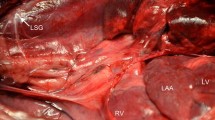Summary
In dog hearts perfused from donor animals, recording and stimulating electrodes were located in the right atrium and in the proximal portion of the bundle of His. The minimal interval between two His responses propagated from the atrium (A-H F.R.P.) was determined, and the recovery of excitability of the bundle was directly measured at the same basic driving frequency.
In the absence of autonomic influences the minimal interval between two His responses propagated from the atrium was longer than the total refractory period (absolute plus relative) of the bundle.
The possibility that a decrease of the action potential of the lower elements of the node was responsible for long delays or block in the activation of the bundle was tested and found unlikely.
During vagal stimulation the recovery of excitability of the bundle and its diastolic threshold were not modified, but the A-H F.R.P. was increased.
During epinephrine administration it was possible on occasion to show that the A-H F.R.P. was equal to the H F.R.P. estimated by stimulating the bundle directly with strong electrical shocks.
These results suggest that in the absence of autonomic influence and during vagal stimulation the weakest link for propagation is located within the A-V node rather than at the junction of node and bundle. During strong adrenergic influences, the functional refractory period of the bundle may be a limiting factor in the propagation of impulses from atrium to the bundle of His.
Similar content being viewed by others
References
Alanis, J.: Propagation of impulses through the specialized tissues of the mammalian heart. In: The Specialized Tissues of the Heart, p. 175. Amsterdam: Elsevier 1961.
— H. Gonzalez, and E. Lopez: The electrical activity of the bundle of His. J. Physiol. (Lond.) 142, 127 (1958).
— J. J. Mandoki, and G. Pilar: Propagation of impulses through the atrioventricular node. Amer. J. Physiol. 197, 1171 (1959).
Cranefield, P. F., B. F. Hoffman, and A. Paes de Carvalho: Effects of acetylcholine on single fibers of the atrio-ventricular node. Circulat. Res. 7, 19 (1959).
Hoffman, B. F., P. F. Cranefield, and J. H. Stuckey: Concealed conduction. Circulat. Res. 9, 194 (1961).
— and A. A. Bagdonas: Electrical activity during the P–R interval. Circulat. Res. 6, 1200 (1960).
—, and P. F. Cranefield: Electrical activity of single fibers of the atrio-ventricular node. Circulat. Res. 7, 11 (1959).
Krayer, O., J. J. Mandoki, and C. Mendez: Studies on veratrum alkaloids. XVI. The action of epinephrine and of veratramine on the functional refraction period of the auriculo-ventricular transmission in the heart-lung preparation of the dog. J. Pharmacol. exp. Ther. 103, 142 (1951).
Mendez, C., C. Gruhzit, and G. K. Moe: Influence of cycle length upon refractory period of auricles, ventricles and A-V node in the dog. Amer. J. Physiol. 184, 287 (1956).
Moe, G. K., J. B. Preston, and H. Burlington: Physiologic evidence for a dual A–V transmission system. Circulat. Res. 4, 357 (1956).
Paes de Carvalho, A., and D. F. de Almeida: Spread of activity through the atrio-ventricular node. Circulat. Res. 8, 801 (1960).
Rosenblueth, A.: (1) Ventricular “echoes”. Amer. J. Physiol. 195, 53 (1958).
— (2) Functional refractory period of cardiac tissues. Amer. J. Physiol. 194, 171 (1958).
Scher, A., M. I. Rodriguez, J. Liikane, and A. C. Young: The mechanism of atrioventricular conduction. Circulat. Res. 7, 54 (1959).
Author information
Authors and Affiliations
Additional information
Dedicated to Professor Otto Krayer on the occasion of his 65th birthday.
With 9 Figures in the Text
Supported in part by grants from the American Heart Association and the New York State Heart Assembly (Oneida County Heart Committee).
Rights and permissions
About this article
Cite this article
Mendez, C., Han, J. & Moe, G.K. A comparison of the effects of epinephrine and vagal stimulation upon the refractory periods of the A-V node and the bundle of His. Naunyn - Schmiedebergs Arch 248, 99–116 (1964). https://doi.org/10.1007/BF00246666
Received:
Issue Date:
DOI: https://doi.org/10.1007/BF00246666



